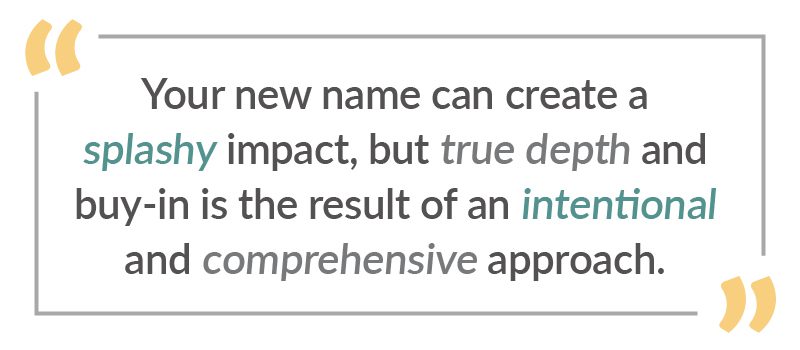HOW TO RENAME WITH CONFIDENCE
Thinking about changing the name of your business or organization? Starting the renaming or rebranding process can be an exciting journey, but it can also bring new and even more challenges right alongside it – getting your team on board, building morale, creating a new logo, updating signage, and outreach materials. Which brings us to the ultimate question: Is it worth it? Is there a right (or wrong) time to evolve your name, if at all?
If you’ve been around for a while, you know we’ve never been one to shy away from a challenge – after all, growth often demands a certain amount of change. However, we do believe there are a few guiding principles to work through prior to making the big leap. Whether you already have a new name in mind (send it our way 😉) or are just starting the process, follow these seven tips and you’ll be well on your way to naming success!
1. Be clear about the “why.”
Doing something different for the sake of doing it is not enough. Changing your name requires more than a “feeling,” so be CLEAR about the why. Look inward, look to your people, and make a strong case for change and the need for a renewed organizational brand. Rally your team around all the good that your organization offers and make it a focus to build trust both internally and externally throughout the process.
2. Assess the impact.
There’s no way around it – changing your name will affect your established brand. Your job is to anticipate as much of the impact before it happens: financial, practical, day-to-day operations, marketing efforts, public perception, etc. There may be some who are averse to this change, and that’s okay. Assessing the impact and developing strong messaging that clearly communicates the “why” will be imperative as you charge ahead!
3. Know what you’re trying to say.
What’s lacking about your current name and what do you want your new name to say about your organization? Is it bold and loud or soft and subtle? Is it a name that highlights your product or is it your culture you’re wanting to lean into? What are the key outcomes you’re hoping to achieve? By agreeing on how you should position the organization, your team will be better enabled to choose a name that says it best!

4. Avoid Common Naming Traps.
Traps or cliches, call them what you want! But watch out for these common practices when deciding on a new name:
Trendy names. Choosing a name that is cool or hip (you know the ones) will generally result in names that wear out quickly and hold a higher potential of being criticized – leading to a depleted impact.
Empty vessel names. Empty vessels require filling. In this same way, made-up or inherently meaningless names will require more time and effort to build understanding and connection.
Names that are too specific. Names that identify specific geography, technology, or trends might be relevant for a season, but in the long run can restrict growth.
5. Understand that a new name can’t do everything.
Names are powerful, but they don’t tell the whole story – or represent your entire brand! When going through the renaming process, it’s important to also rethink and refresh all brand communications. Your new name can create a splashy impact, but true depth and buy-in is the result of an intentional and comprehensive approach.
6. Ensure that you can own it!
Few heartbreaks hit as deep as spending months on end agonizing over a new name only to find that it’s already taken. As you begin to narrow down your options, take the extra step to run them through an experienced intellectual property attorney who can help you determine the potential for trademark. If you’re going to invest in a new name, make sure you can own it!
7. Transition with confidence.
Ready to shout it from the rooftops? While deciding on a new name is half of the battle, the other half is releasing it into the world. Here are a few things to keep in mind as you prepare for the big day:
- Develop a value-oriented story to communicate around your new name.
- Be clear about the benefits to employees, customers, and interested parties.
- Charge with confidence – implement as quickly and thoroughly as possible to avoid confusion with internal and external audiences.
- Lean into trusted partners to help with the transition.










